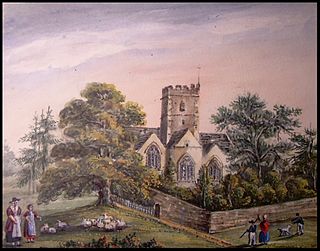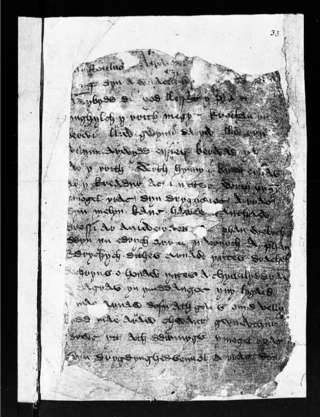
The Red Book of Hergest, Oxford, Jesus College, MS 111, is a large vellum manuscript written shortly after 1382, which ranks as one of the most important medieval manuscripts written in the Welsh language. It preserves a collection of Welsh prose and poetry, notably the tales of the Mabinogion and Gogynfeirdd poetry. The manuscript derives its name from the colour of its leather binding and from its association with Hergest Court between the late 15th and early 17th century.

The National Library of Wales, in Aberystwyth, is the national legal deposit library of Wales and is one of the Welsh Government sponsored bodies. It is the biggest library in Wales, holding over 6.5 million books and periodicals, and the largest collections of archives, portraits, maps, and photographic images in Wales. The Library is also home to the national collection of Welsh manuscripts, the National Screen and Sound Archive of Wales, and the most comprehensive collection of paintings and topographical prints in Wales. As the primary research library and archive in Wales and one of the largest research libraries in the United Kingdom, the National Library is a member of Research Libraries UK (RLUK) and the Consortium of European Research Libraries (CERL).

The Welsh Triads are a group of related texts in medieval manuscripts which preserve fragments of Welsh folklore, mythology and traditional history in groups of three. The triad is a rhetorical form whereby objects are grouped together in threes, with a heading indicating the point of likeness; for example, "Three things not easily restrained, the flow of a torrent, the flight of an arrow, and the tongue of a fool."

The White Book of Rhydderch is one of the most notable and celebrated surviving manuscripts in Welsh. Mostly written in southwest Wales in the middle of the 14th century it is the earliest collection of Welsh prose texts, though it also contains some examples of early Welsh poetry. It is now part of the collection of the National Library of Wales, having been preserved in the library at Hengwrt, near Dolgellau, Gwynedd, of the 17th century antiquary Robert Vaughan, who inherited it from the calligrapher John Jones and passed it to his descendants. The collection later passed to the newly established National Library of Wales as the Peniarth or Hengwrt-Peniarth Manuscripts.

The Black Book of Carmarthen is thought to be the earliest surviving manuscript written solely in Welsh. The book dates from the mid-13th century; its name comes from its association with the Priory of St. John the Evangelist and Teulyddog at Carmarthen, and is referred to as black due to the colour of its binding. It is currently part of the collection of the National Library of Wales, where it is catalogued as NLW Peniarth MS 1.
In some old Welsh texts, Eliwlod is a nephew of King Arthur. His father is Madoc, son of Uther Pendragon, an obscure brother of Arthur's mentioned a very few times in Welsh literature.

Brut y Tywysogion is one of the most important primary sources for Welsh history. It is an annalistic chronicle that serves as a continuation of Geoffrey of Monmouth’s Historia Regum Britanniae. Brut y Tywysogion has survived as several Welsh translations of an original Latin version, which has not itself survived. The most important versions are the one in Robert Vaughan's Peniarth MS. 20 and the slightly less complete one in the Red Book of Hergest. The version entitled Brenhinoedd y Saeson combines material from the Welsh annals with material from an English source.
Lewys Glyn Cothi, also known as Llywelyn y Glyn, was a prominent 15th-century Welsh poet who composed numerous poems in the Welsh language. He is one of the most important representatives of the Beirdd yr Uchelwyr or Cywyddwyr ("cywydd-men"), the itinerant professional poets of the period between the 1284 Statute of Rhuddlan and c. 1600.

Peredur son of Efrawg is one of the Three Welsh Romances associated with the Mabinogion. It tells a story roughly analogous to Chrétien de Troyes' unfinished romance Perceval, the Story of the Grail, but it contains many striking differences from that work, most notably the absence of the French poem's central object, the grail.
Brenhinoedd y Saeson is the medieval title of a Middle Welsh annalistic chronicle. The name means 'the kings of the English'.

Brut y Brenhinedd is a collection of variant Middle Welsh versions of Geoffrey of Monmouth's Latin Historia Regum Britanniae. About 60 versions survive, with the earliest dating to the mid-13th century. Adaptations of Geoffrey's Historia were extremely popular throughout Western Europe during the Middle Ages, but the Brut proved especially influential in medieval Wales, where it was largely regarded as an accurate account of the early history of the Celtic Britons.

Gwladys ferch Dafydd Gam was a Welsh noblewoman. She was the daughter of Dafydd ap Llewelyn ap Hywel, otherwise known as Dafydd Gam, who was killed at the Battle of Agincourt in 1415.

The Coelbren y Beirdd is a script created in the late eighteenth century by the Welsh antiquarian and literary forger Edward Williams, best known as Iolo Morganwg.
The Black Book of Chirk is a 13th-century Welsh-language manuscript, known also as the Chirk Codex. It is Peniarth 29 of the National Library of Wales, and deals with legal and historical matters. It contains also an elegy addressed at Llywelyn ap Iorwerth; king of Wales. This poem was probably written by his grandson Llywelyn ap Gruffudd who lived in the 13th century.
Peniarth 109 is a Welsh manuscript dating to the second half of the 15th century in the hand of the poet Lewis Glyn Cothi. It is part of the Peniarth Manuscripts collection at the National Library of Wales.

Peniarth 51, otherwise known as Llyfr Gwilym Tew, is a Welsh manuscript written in the second half of the 15th century. It is mostly in the hand of the bard Gwilym Tew. Although it is known that Gwilym wrote other manuscripts, Peniarth 51 is the only entire manuscript that can be proven to have been his work. It is kept in the National Library of Wales, Aberystwyth, as part of the Peniarth Manuscripts collection.
Thomas Wiliems was a Welsh-language antiquarian.

"The Magpie's Advice" or "The Magpie's Counsel" is a poem in the form of a cywydd by the pre-eminent Welsh-language poet, Dafydd ap Gwilym. The poet portrays himself as an overage lover who bemoans his romantic woes as he wanders through the woods, and is rebuked by a magpie who bids him concern himself with matters more befitting his years. It can be read either as a comic and self-mocking reversal of the traditional Welsh poetic trope of the non-human messenger, or llatai, being sent to the poet's lover, or as a meditation on the contrast between the yearly cycle of renewal in the natural world and the linear ageing of men, which falsifies any simplistic identification we may make with nature. It has always been one of Dafydd's more popular poems, surviving in 55 manuscripts and being widely translated in the 20th and 21st centuries. Sir Thomas Parry included it in his Oxford Book of Welsh Verse.












